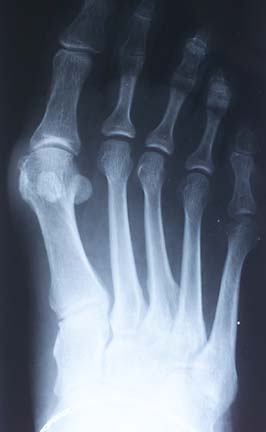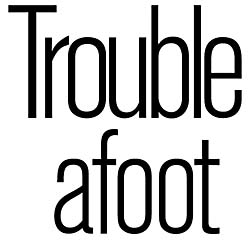
RICHARD WALKER / RWALKER@STARBULLETIN.COM
Carolyn Teske had a deformity of her big toe, caused by her love of high heels.Cinderella's sisters tried everything to cram their big feet into a petite glass slipper, going as far as cutting off a toe and a heel -- in the original, not Disney version of the story -- to obtain the hand of Prince Charming.
Doctors orders won't keep
Building a better shoe
women away from heels and
pointy shoes even after surgeryBy Pat Gee
pgee@starbulletin.comThousands of years later, women are still putting their feet through hell in order to fit into anything pointy and high-heeled, short of Chinese foot binding.
With total disregard for pain, bunions and "pump bumps," normally sensible, liberated women will do almost anything to fit into something pointy, strappy and stiletto-oriented in the name of fashion. Simply donning a pair of heels transforms them from feeling too dumpy for words to sublimely sexy.
Little girls playing dress-up immediately feel more sophisticated and grown up the moment they slip into Mommy's heels. Tottering about the living room, they learn quickly that they don't have to utter a single word to exclaim, "Look at me!"
Those who aren't blessed with naturally pointed toes (is anyone?) and cannot claim a size 6 narrow as their own, will still pursue that I-am-woman feeling every time she puts on a pair of heels. And that's why foot doctor Ken Howayeck's business is booming.
RICHARD WALKER / RWALKER@STARBULLETIN.COM
Dr. Ken Howayeck examines Teske's feet in his office.
Seventy percent of his patients are women, many of them young, fashion-conscious types who are seeking relief from pain caused by high heels that are too narrow, said Howayeck, a podiatrist with the Academy Foot Center of Hawaii, next to the Queen's Medical Center.
"So many problems are caused by heels higher than 1 1/4 inches," said Howayeck, who has been practicing in Hawaii since 1991. Heredity is the other common cause of foot problems, he added.
His work involves "making things smaller, removing the bumps and prominent areas of the foot," such as bunions near the big toe and bunionettes on the baby toe, calluses on hammer (curled) toes, and "pump bumps" or bony growths on the Achilles tendon, Howayeck said.
"So many people are wanting their toenails narrowed."
What!?
This procedure involves narrowing one or more nails permanently to relieve pressure and tenderness caused by a nail that is ingrown, stubbed or rubbed by an ill-fitting shoe.
RICHARD WALKER / RWALKER@STARBULLETIN.COM
This X-ray is of Carolyn Teske's foot after surgery to correct the deformity of her big toe."We're doing that left and right, and they are always happy with the results," he said. (Cinderella's sisters certainly could've used his services.)
"We NEVER do things solely for cosmesis (cosmetic purposes). Cosmetics is a byproduct (of fixing a problem)," Howayeck said.
But fixing one problem doesn't mean it's the last time Howayeck sees a patient, when "against our advice" patients go back to wearing narrow high heels because they can wear them more comfortably following surgery.
In spite of the current demand for pointy shoes, Howayeck has seen the same types of foot problems for decades and realizes that no amount of advice will stop a person from donning a favorite pair of Manolo Blahniks or Jimmy Choos.
"Function often is given a back seat," he said, when appearance is involved. "We understand that they insist on doing it, and then we roll our eyes."
One of Howayeck's patients, Carolyn Teske, of Mililani, was recovering from bunion surgery when Howayeck caught her three weeks later wearing high-heeled sandals.
RICHARD WALKER / RWALKER@STARBULLETIN.COM
Carolyn Teske and Dr. Ken Howayeck discuss her before and after photos. Even after Teske underwent surgery to correct foot problems caused by shoes, the doctor caught her going back to high heels.
At the time, he commented, "Those are really nice orthopedic shoes," she recalls with a big laugh. She was supposed to be wearing flat, splintlike, "ugly" sandals that "drove me crazy" for at least the first six weeks.
Teske said she was "thrilled" that she could wear her high-heeled boots to Las Vegas once the period was up, and now wears heels about twice a week with no problems. Howayeck had shaved a half-inch of bone off the offending growth at the joint right next to her big right toe, but it feels about an inch narrower, she said, judging from the shoes she can now wear. She is still seeing the doctor about numbness in her toe, but it hardly bothers her.
Teske said the first thing she did six weeks after surgery was to try on all of her 30 pairs of heels, which average about 2 inches in height. Most of them are pointed and open-toed.
"Women will do almost anything to wear fashionable shoes," said Teske, who adorns her feet with an ankle bracelet, toe rings and acrylic daisies on her toenails.
As a nurse, she suffered from a painful "huge bunion" after working on her feet for 10 years. After hours, she could manage two hours of wearing high heels before having "to go home and sit."
Howayeck called podiatrists "the foot's advocate, but they (clients) don't want to hear what we tell them. So we'll do our best to accommodate their wishes. Our job is to enhance the quality of life for the long term, allowing them to live the life they want to live."
"Podiatrists are supposed to tell you to never wear higher than a 1 1/4-inch heel, and wear the ugliest shoes you can find," he joked, laughing.
Devie Durupan, a medical assistant for five years at the Academy Foot Center, also had surgery on her right bunion two years ago, and, when she can find time to hobble around for six weeks, will schedule surgery on her left one.
She has seen a lot of women who went through surgery go right back to high heels.
"They've either learned their lesson or they try (heels) again and come back six months later," she said.
Durupan counts herself as one of the die-hards because, "I have all these weddings I have to go to," either as a bridesmaid or a guest. When it comes to looking elegant, for her, comfort shoes just don't deliver.
BACK TO TOP |
RICHARD WALKER / RWALKER@STARBULLETIN.COM
Podiatrist Taryn Rose, right, decided to do something about her patients' complaints and designed a line of shoes that combine comfort and style. Here, she talks with customer Diane Kudo, at Neiman Marcus.
Sure, high heels and pointy toes look sexy, but they can inflict damage that go beyond the foot. A heel higher than 1-1/4 inch can throw off the body's alignment, leading to ankle, knee, hip and lower back problems. The heel also causes the body's weight to rest on the toes. If squeezed into a point, the joint of the big toe may develop bony growths called bunions. With nowhere to go, the big toe may also slide under the second toe, causing deformity. Beautiful, you say? If you can’t beat ’em,
build a better shoeStubborn clientele led orthopedic surgeon
Taryn Rose to take shoe design to heartBy Pat Gee
pgee@starbulletin.comBeauty and comfort. The two concepts do not have to be mutually exclusive.
You can even gain 2 inches of height without pain in shoes designed by podiatrist Dr. Taryn Rose, of Los Angeles.
Women with foot problems, including Hollywood stars, have found bliss in elegant shoes engineered by the orthopedic surgeon who pioneered the concept of "couture comfort" four years ago.
She was at the Ala Moana Center Neiman Marcus store Saturday, greeting customers who either exclaimed, "I love your shoes!" or new ones who gushed, "My daughter/sister/ friend told me how wonderful they are!"
Why does a doctor become a shoe designer? She found a need and filled it based on her patients' needs. Most of them refused to wear unattractive flats even though fashionable styles were causing foot deformities. They couldn't find shoes that were comfortable that they considered beautiful, she said.
Rose's designs feature breathability, full arch support, ample cushioning, anatomically correct shaping (no pointed toes) and flexibility. They are handmade in Italy and average $350 a pair.
Posted on her Web site, tarynrose.com, are revealing statistics compiled by the American Orthopedic Foot and Ankle Society:
>> 90 percent of foot surgeries in the United States are done on women.Convinced by Rose that I wouldn't be able to write about the comfort level of her heels unless I tried them on, I happily obliged for an hour, following her around as she spoke with customers. I chose a black 2-inch (that's as high as she goes) pair of sandals with a half-inch-wide band in the center.
>> 82 percent of women suffer from foot pain.
>> 72 percent of women suffer from one or more foot deformities.
>> 86 percent of women wear shoes one or two width sizes too small.
>> 50 percent of women can't find dress shoes that are fashionable and comfortable.Considering I have "luau," a k a duck feet, and was told they only had medium widths on hand, my toes felt quite free to spread out.
Meanwhile, the balls of my feet rested on what felt like tiny mattresses. The cushioning was made with a sponge called Poron so resilient, I was told, that it would bounce back even if you left a grand piano on it for a year. The section under my arch was higher and wider than most shoes, so the balls of my feet didn't have to carry as much weight on their own.
On top of that, they didn't leave the usual angry red welts when I reluctantly had to give them back.
Customer Diane Kudo of Manoa bought three pairs almost a year ago on the mainland. Citing their luxury-class price, she said she had sticker shock at first. "But I don't regret it. There was no breaking-in period, no blisters," she enthused, saying she "walked all over Japan" in a black mircrofiber wedged heel with no problems.
"I keep telling my mom about them. I have to try and bring her in. She has a bunion," she said. "And all of her (Rose's) shoes are extremely light!"
Rose said she doesn't believe in making heavy shoes. Just as your arms would tire from lifting weights all day, wearing heavy shoes all day is the equivalent of lifting weights with your legs.
Another customer said she heard about the shoes on "The Oprah Winfrey Show" and read about them in a magazine.
A saleswoman who is on her feet all day gushed, "I love your shoes!"
A lot of Rose's patients have made the switch from 2-inch-plus shoes to Rose's lower heels, but to them the change was well worth the sacrifice of an elongated legline.
"My customers are at a point in their lives where they don't need to follow the beauty dictates (of fashion)," Rose said. "My patients are very intelligent, confident women.
"I'm not trying to convert the world; I'm just offering another option to women who want and need an option. I just want women to stay healthy and feel beautiful and comfortable.
"Even I will occasionally wear a pair of Manolo Blahniks, but I don't eat dessert after every meal, either. Except here -- I love that lilikoi (dessert)."
Click for online
calendars and events.






